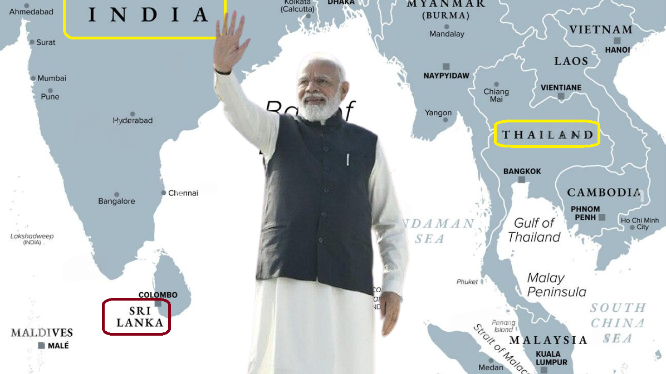
- Ramayana’s influence extends past national frontiers for hundreds of years to define the cultural, religious, and social developments of Thailand, Indonesia, Cambodia, and Malaysia.
- Cultural diplomacy plays a vital role in India-Sri Lanka relations because both nations share their Buddhist history and cultural connections stemming from the Ramayana.
- PM Modi’s tour of Thailand and Sri Lanka represents a diplomatic mission combined with the effort to connect historical cultural bonds with current geopolitical demands.
Indian Prime Minister Narendra Modi will be on a visit to Thailand and Sri Lanka between April 3 and April 6, 2025, as he combines cultural connections with the current geopolitical framework. The journey demonstrates how India uses its shared cultural heritage related to Ramayana to implement strategic objectives in both South Asian and Southeast Asian regions to resolve critical regional issues.
Ramayana: A Shared Cultural Heritage
Through epics like the Ramayana, Indian culture extends its bridge across Southeast Asia. Ramayana’s influence extends past national frontiers for hundreds of years to define the cultural, religious, and social developments of Thailand, Indonesia, Cambodia, and Malaysia. The Ramakien, inspires classical dance along with literature and visual art for the people of Thailand through its adaptation of the Ramayana. In Cambodia, Angkor Wat presents elaborate wall carvings illustrating Ramayana stories and Indonesia allows local native legends to appear within their Ramayana text.
The Indian Council for Cultural Relations (ICCR) sponsors multi-city celebrations of Ramayana heritage through their Ramayana Festival initiative. The ongoing efforts prove how the epic combines to establish cultural unity between ASEAN member nations. PM Modi’s visit will strengthen diplomatic relationships through cultural and economic, and strategic partnerships.
Thailand: Strengthening Regional Cooperation
The 6th BIMSTEC Summit is the starting point of PM Modi’s foreign visit when he arrives in Bangkok on April 4. The seven member states comprising BIMSTEC (Bay of Bengal Initiative for Multi-Sectoral Technical and Economic Cooperation) empower regional collaboration through cooperation between India, Thailand, Sri Lanka, Bangladesh, Myanmar, Nepal, and Bhutan. economic growth and security stand as the primary areas of shared interest during the BIMSTEC summit, which focuses on its theme of “BIMSTEC – Prosperous, Resilient and Open”.
India’s Act East Policy functions as the central framework for Indian participation with Thailand. The Act East Policy began developing in the 1990s, but following PM Modi’s leadership after 2014, it centered on developing economic and defence cooperation with Southeast Asian countries. India faces obstacles when trying to strengthen its eastern neighborhood because Bangladesh remains politically unstable, while Myanmar faces an ongoing civil war. During the summit, India can strengthen its pledge to maintain regional stability by confronting the present challenges.
PM Modi will be having official talks with Thai Prime Minister Paetongtarn Shinawatra during his meeting. During their talks the leaders will explore ways to advance economic collaboration as well as Buddhist and Ramayana cultural relations alongside maritime safety partnerships. The position of Thailand within ASEAN corresponds to the wider Indo-Pacific strategy of India in its efforts to undermine Chinese interests in the area.
Sri Lanka: Balancing Geopolitical Dynamics
Prime Minister Modi made his last visit to Sri Lanka during a pivotal time after major political transformations in Colombo occurred. New Delhi had expressed concern as the leftist-nationalist government of Janatha Vimukthi Peramuna (JVP) had openly vouched for further ties with China. India acted by providing grant-funding to projects that target the reduction of Sri Lankan dependency on Chinese support. During his visit to Anuradhapura PM Modi will open development projects which were funded through Indian assistance programs to deepen the economic bond.
The talks between President Anura Kumara Dissanayake and India will review the implementation of the “Joint Vision for Fostering Partnerships for a Shared Future.” The partnership between the two countries focuses especially on developing joint energy initiatives and building infrastructure across the nation. The actions support India’s Neighbourhood First Policy and challenge the Belt and Road Initiative (BRI) presence of China throughout Sri Lanka.
Cultural diplomacy plays a vital role in India-Sri Lanka relations because both nations share their Buddhist history and cultural connections stemming from the Ramayana. The visit takes place during ceremonies that celebrate the 70th anniversary of diplomatic ties between Sri Lanka and Thailand, indicating how cultural ties enhance contemporary partnerships.
Geopolitical Context
Multiple global political aspects have created additional challenges for PM Modi’s trip. The condition in Southeast Asia poses growing difficulties for India because of political instability in Myanmar and Bangladesh. BIMSTEC’s regional connectivity activities has been disrupted because of Myanmar’s civil war in combination with the political turmoil in Bangladesh after Sheikh Hasina’s departure from power. India’s influence in South Asia faces direct competition from China continues to enlarge its presence in the region through both infrastructure agreements and strategic partnerships.
The engagements of PM Modi with Thailand and Sri Lanka hold important strategic value for this situation. India depends on Thailand as its primary ASEAN union member to implement its Indo-Pacific vision while the Sino-US competition grows. Sri Lanka serves as a crucial location for the effort to diminish the effects of Chinese economic aid alongside soft power diplomatic initiatives.
Conclusion
PM Modi’s tour of Thailand and Sri Lanka represents a diplomatic mission combined with the effort to connect historical cultural bonds with current geopolitical demands. Through a combination of remedying current regional challenges through BIMSTEC and bilateral agreements alongside the promotion of Ramayana heritage, India functions to enhance its authority in South Asian and Southeast Asian regions. Through this current diplomatic journey, New Delhi demonstrates its commitment to building peaceful, prosperous, and resilient conditions across the Indo-Pacific region while facing neighbours’ geopolitical tensions and instability.
References-
- Ramayana festival with ASEAN nations in 6 cities from Jan 20: https://www.business-standard.com/article/pti-stories/ramayana-festival-with-asean-nations-in-6-cities-from-jan-20-118011801149_1.html
- Amid Unrest in Neighbors, India’s Act East Policy Faces New Headwinds-https://thediplomat.com/2024/08/amid-unrest-in-neighbors-indias-act-east-policy-faces-new-headwinds/
- Sri Lanka, Thailand to strengthen bilateral ties through Cultural, Economic, and Strategic Cooperation: https://www.dailynews.lk/2025/01/31/local/714598/sri-lanka-thailand-to-strengthen-bilateral-ties-through-cultural-economic-and-strategic-cooperation
- Prime Minister Modi to visit Thailand and Sri Lanka for BIMSTEC Summit, bilateral talks-https://www.indianewsnetwork.com/en/20250328/prime-minister-modi-to-visit-thailand-and-sri-lanka-for-bimstec-summit-bilateral-talks
Parag Gilada is a Mukherjee Fellow who has recently graduated from the Jindal School of International Affairs with a keen interest in Sports Diplomacy. Views expressed are the author’s own.
